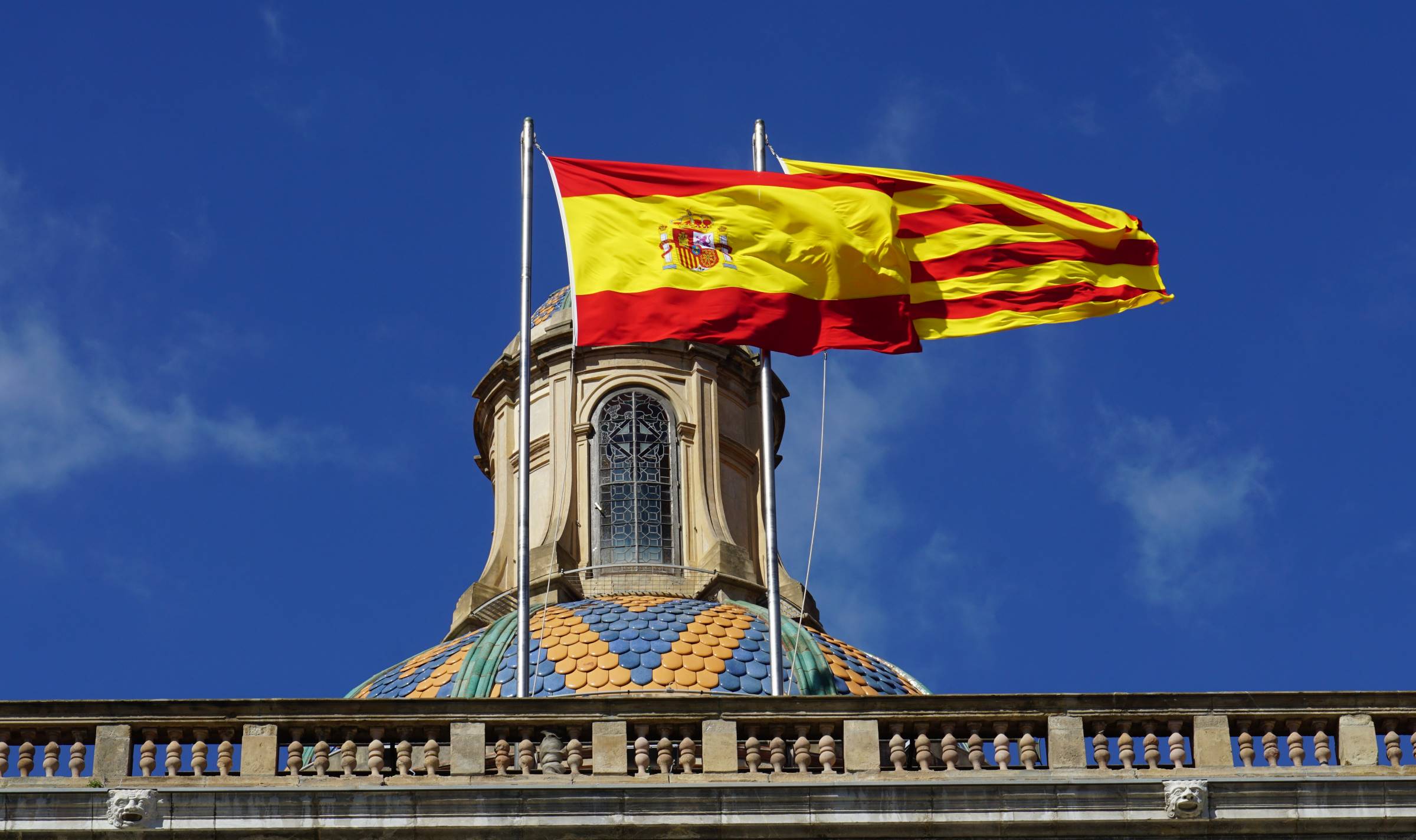
Around the World in 1998-1999; Southern Spain and Barcelona
Note; this post is recreated from the original wired2theworld website post with the dates below. The old posts were reformatted for the 20th anniversary of wired2theworld. As much as possible, the content is unchanged and unedited from the original, only some formatting, spelling, and link errors have been corrected.
Table of Contents
Cadiz Spain
Kristina’s Journal:
US$1=151 ptas.
March 9, 1999
Today we drove all the way to Cadiz in the south of Spain. We were hoping for a little port town we remembered from 10 years ago (when we’d lived in Madrid) which had amazing seafood. Not to be found. Now we think it was another town. This place is very expensive and we felt fortunate when we found a nice room with the toilet down the hall and again no phone. We will try again tomorrow in Algeciras, but if we have no luck, we will have to wait until after we get back from Morocco to get connected.
We did find one nice moment in Cadiz, a Sherry Taberna called “La Manzanilla” at Feduchy 19. As we walked past, we saw a large brightly lit room with big wooden kegs and a polished wood bar. The only thing served here was sherry, but many different kinds. We had a few different types to taste the old and new…
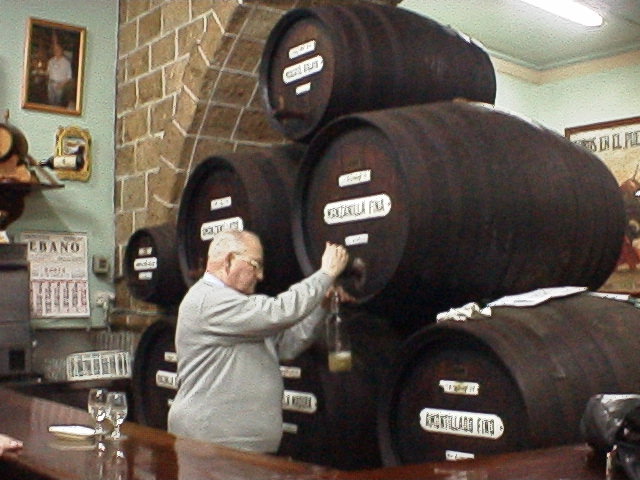
David’s Diary:
March 9, 1999
…I know I can find it…
We were having one of those evenings where everything goes wrong and we finish up wandering like zombies around the old part of a city arguing about which way to go next until hunger takes over and finally drives us into a restaurant.
It was very much like that, too, with a few added factors just to make it exceptional. It was raining, and it was cold. I took off in the car from the tourist office without consulting the map, and was immediately lost in a lunatic maze of ancient streets just barely wide enough to allow the car and the mirrors passage- lookout pedestrians! Kristina and I were definitely arguing about something, and in due course, it was clear that where we wanted to be was just feet away from where we had been parked at the Tourist office. Needless to say, I felt like an idiot inside and, to the best of my memory, blamed Kristina for not navigating fast enough. The things we do to save face…
After parking again in the same lot we had left behind 30 minutes ago, so prematurely, we were attacked by an older tout. Bad first impression, when the first hawker to accost us was representing- you guessed it!- the same place we were seeking and the only one we liked on the list. To no surprise of mine, it did not live up to the description it was given in the guide, and so we left in a huff.
Then, we did the usual, and walked around the neighborhood, and found the cheapest, most comfortable pension that we could. That done, we forced our tired selves out into the rain and cold and set off in search of a fish market that specialized in frying fresh seafood and serving it to you with sauce in a big paper. After about an hour of pointless meandering, similar to the pointless meandering we had performed earlier in the car, we came to the realization that we had confused this town with another town nearby, also in Andalusia.
Totally dejected, and not thrilled with our short stay in Cadiz thus far, we were having trouble winding through the dark labyrinth alleyways back to the area around the hotel. The Spaniards, like many Europeans, have mastered the art of concealing the identity of the street. Everywhere we go, our map has street names, but the streets only have them sometimes, and then it is usually a one way street that was not indicated as such on your map.
As we stomped past the sherry bodega, I was taken by the stack of barrels inside. Our quest was diverted, and our hypoglycemic rage falling away to inquisitive euphoria, we staggered in, straightened up to the bar, and without need for consultation, we decided it was indeed time for an aperitif!
I looked down at the bottles he was filling, and noticed that nothing had a label on it. Bring your own bottles, it’s cheaper. We tried two or three kinds of sherry, some 50 to 100 years old, some less than a decade, all delicious. The guy behind the counter was very kind, and we were each given a little tapa of olives with our sherry. He showed us the really big barrels in the backroom and offered us bottles of vintage sherry from the 30’s and 40’s. Totally out of budget. But, not the stuff we had been drinking from the barrels in the front, which was only a few bucks a bottle, except for the 50+ year old stuff. So we picked the one Kristina liked, a fruity young manzanilla sherry, and bought a bottle to go.
We settled on dinner in a little diner-style place, and it was mediocre, but it didn’t matter, because we could leave Cadiz in the morning and get to our real destination: Algeciras, and from there, Morocco. We had our sherry now, and it could take up its place in the mobile bar we always seem to develop when we travel with four wheels. We were now traveling with two bottles of Ginja, two bottles of Port, and a bottle of sherry. Having been somewhat mellowed by the experience, we looked back at the evening and determined that it was not as bad as we had originally thought.
Algecerias
Kristina’s Journal:
March 10, 1999
Algeciras is a dirty little port town with not much going for it for the tourist except for its proximity to Gibraltar and the ferries that depart daily for Morocco. We arrived early, determined to do three things that day; find a room with a phone, do our laundry, and organize a two-day trip to Morocco.
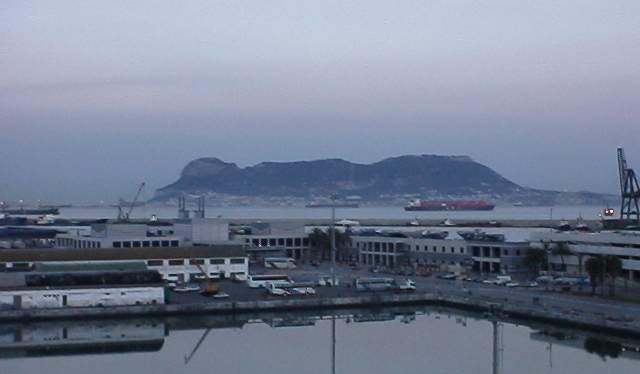
We arrived to find quite a few small pensions clustered near the port, but none with phones in the room. As we started to look at the hotels that offered phones, we quickly realized that they were completely out of our budget, and on top of that, most had hard-wired phones in the room, of no use to us. Finally, after much perseverance, we found a residencia right on the street that borders the port. This pension was high up on the 8th floor and offered basic rooms with bathroom and telephone for only 4000 ptas a night. We had a room with a wonderful view of Gibraltar and we were able to get our email, finally.
Next, to do laundry. As we may have mentioned before, this is no easy task. There were no do-it-yourself, coin-operated laundromats in Algeciras. But, luckily the owner of the pension told us of a place that was inside the port, the Lavanderia El Puerto. We went there, and of course, it was closed for siesta. We went back later in the afternoon, and pleaded with the woman who runs the two machines inside to do our laundry for us and have it ready by early evening. Initially, she told us it would not be ready until the morning, after we left for Morocco, but finally she agreed to put our dirty wash ahead of someone else’s. Of course, all this comes at a price; two loads of clothes, washed and dried, cost 1800 ptas!
Now, for Morocco. All along the street that borders the port are travel agencies offering trips to Morocco, mostly for trips there and back in one day. We walked into five or six different agencies intent on comparing prices for a two-night/three-day trip to Tangiers.
Initially, when we were planning this journey, we had intended to spend a few weeks in Morocco, but now that we have the car, it seemed silly and wasteful to let the car sit while we were paying for it and for parking. So, we decided to just get a little taste and spend a couple of days there. We didn’t want to waste time looking for a place to stay, so we wanted to book a hotel in advance. What we found, however, was that there was very little choice available. Even though there were numerous agencies, they all offered the same choice; a package that included a tour of the city, two nights in a beachside hotel, including breakfast and dinner. Same price everywhere, same hotel.
Since we weren’t looking for a beach vacation, we asked if any hotels we available inside the town. The answer was yes, but for more than we were willing to spend. So, we opted for the beach hotel, assured that it was only a ten-minute walk from town. Along with this package, we purchased a heavily discounted night at a hotel in Algeciras for the night we returned. It wasn’t too expensive, not really that much more than the day tour itself, although we got the feeling that not too many people were taking this option.
That night we decided to bring only one small backpack with us and to leave our car parked in the garage of the hotel we were to return to, with all our luggage stored inside the hotel. We found one fun little place to eat, a pizza/sandwich shop called Trafalgar 5, on the street with the same name. They make great, inexpensive pizzas and lomo sandwiches in a rock n’ roll memorabilia setting.
Algecerias to Costa del Sol
Kristina’s Journal:
March 12 and 13, 1999
When our ferry arrived back in Algeciras from Tangiers late in the afternoon, we went straight to the travel agency Deltatour (Acera de la Marina, 1) to talk to them about a possible refund, not expecting to see a dime. Instead, we found not only the nice guy who sold us the package (and dealt with us on the phone from Morocco), but the owner of the agency as well. Rafael Gonzalez turned out to be very sympathetic, and, as most of the Spaniards we met down there, seemed to hate Morocco and Moroccans and was not surprised by our tale of woe.
Note; we don’t hate Morocco or Moroccans, and fully intend to go back to Morocco someday, just not on a tour to Tangiers.
More on our experience in Morocco in a separate post.
He said he could only issue us a refund for the unused portion of the package if the Hotel did not bill the tour operator. However, he would not know this for a few days, long after we had left. And, unfortunately, unlike the US, he was not allowed to issue a credit for the difference directly to our credit card. So, he devised a clever idea for us; he ran a credit slip for 6000ptas (the difference), gave us the cash, and then said he would only run the charge card if the tour operator did not issue a refund. If they did, he would tear up the charge receipt and we would already have the cash! Sold! As of writing this over 6 weeks later, we still have not been charged, so maybe we got lucky.
Costa del Sol to Barcelona
David’s Diary:
March 14, 1999
From the moment we left Algeciras, things started to look bad for us. The boredom factor was steadily rising. I was unable to amuse myself by driving really fast, still sore from the ticket in Portugal. Finally, we both realize what is bothersome about the utterly blah countryside. Everything is covered with plastic. It’s as though somebody said “let’s cover all the farmland with raised plastic tarps from here to the next freakin’ mountain range!”, and the word got out somehow.
We drove for hours and the scene did not change, from more of the same to more of the same to more….are my wheels turning or are we standing still? Eventually, the tarps became the object of our curiosity, and we pondered the ‘why’ of it all. Were they designed to shield the crops from the summer sun? Perhaps too much of a pain to take down for the winter. Who knows. It went on for hundreds of miles, however, so they must be growing a lot of it.
We stopped after dark, having turned the corner on the Iberian Peninsula and forged our way North along the east coast of Spain. We found a hotel in Calpe, just north of the hideous resort town of Benidorm which is plagued with mirrored high-rise condos and smokestacks end to end. Hotel Rocinante (tel. 965 83 1200 on the highway to Alicante) was an oasis in a part of Spain where there is not much else. The French couple who moved to Calpe, bought a hotel, and remodeled it, were very pleasant and friendly. They wanted out of the rat race, so they packed out to the desert coast of Spain and opened a little resort hotel. Although not on the beach, this hotel had a very nice view and a very nice pool. The set menu was very French, and that turned out to be an advantage, as the food was properly prepared for the first time since, well, France. The food was good, and not expensive, and the owners, who ran the place alone during the off-season, were wonderful hosts.
Barcelona
David’s Diary:
March 15, 1999
We began early, after a nice breakfast of homemade croissants and good coffee. Off to Barcelona. I love Barcelona. I love it for the feeling of the old town, mostly. It feels smaller than some cities because there is always an animated mob of people in the heart of the old city, and because the city is designed with the flow of life in mind. The neatest part of the tourism infrastructure of Barcelona is that is designed with the pedestrian in mind, and because it is primarily architectural in nature, there are always other people walking the streets looking at buildings alongside you. You can find a Herald Tribune anywhere, and McD’s and BK are on the same corner, and there is nothing you can’t walk to that you would want to see anyway.
The kiosk we bought our Tribs from had the most adorable cat working there. It was all gray and extremely cuddly. It had a tag, which is rare in Europe, and on the tag was inscribed “I live in the kiosk at the corner of Las Ramblas”. The cat was used to more than its share of love, and was therefore the instant object of Kristina’s unbridled affection. We would end up spending about five minutes a day with the cat, then buy our paper, sheepishly thank the owners, and be on our way.
Kristina’s Journal:
March 14, 1999
Barcelona
When we got there, we walked around for almost two hours before we found a place we liked that we could afford. The Pension Lima was clean, had a bathroom in the room, and is well located, but no phone, only drawback. It is near the Plaza Cataluna, on Calle Fontanella, 16 (tel. 318 5765)and it cost 5000 ptas a night ($33). We saw other places that were more money for much less quality. As usual, the bigger the city, the higher the cost of accommodation. Also, we discovered that the tourist office is underground in the Plaza Cataluna and open from 9-9 daily, contrary to what our guide book said.
North of Plaza Cataluna, on Passeig de Gracias 8-10, we found a tapas bar called Txapela, Euskal Taberna that serves tapas in the style of North-Eastern Spain called pintxos. Since we had enjoyed this in San Sebastian, we decided to give it a go here, and while we were at it, we tried the traditional Sidre (cider) as well. We had skewers of octopus and marinated vegetables, little toasts piled high with Burgos cheese, tomato, and anchovy, or smoked salmon with slices of hard-boiled egg. There were at least thirty different little tastes to choose from. It turned out to be a bit pricey for us, but it was good fun for once.
| Kristina’s Notes: Modernisme and the Ruta de Modenisme Pass Barcelona has a wealth of sightseeing prospects, most connected in some way to the architect/designer Gaudi and his turn-of-the-century style called Modernisme. The Modernisme style is very similar to the Art Nouveau of the same time. However, Gaudi was unique and put his indelible stamp and brilliant artistry on just about everything he touched. Catalan Modernisme is described as “a rich avant-garde ornamental style with certain political connotations. It was looked upon as a national art linked closely with a political project, namely catalanisme. It was a style that combined traditional nationalistic symbols…” Gaudi, being a staunch Catalan nationalist employed not only the signs and symbols of Catalan history in his architecture but in every aspect of his design.” Not only were many of his designs fanciful, but many of them were ground-breaking and functional at the same time. The Ruta del Modernisme discount card is sold at only three locations in Barcelona. This card cost us 400 ptas each (with student ID-800 ptas without) and gives 50% off admission and special access/tours to the fifty sites along the route throughout Barcelona. Some places even give student discounts on top. Usually, I think discount cards that you have to pay for, and then pay again, aren’t worth it, but given all the sites we wanted to see and the cost of admissions, it seemed cost-efficient. With the pass, we received a map to all the sites and a wonderful guidebook in English not only to the sites but other things of note along the way. |
March 15, 1999
Barcelona
The first thing we did in the morning was go to the Casa Lleo Morera, one of the locations where the Ruta del Modernisme discount card is sold. The Casa Lleo Morera, is one of three historical buildings on a block of the oldest residential areas of Barcelona called the Eixample. The block has been named the mancana de la discordia (the apple of discord). Nowhere else in Barcelona is it possible to see three distinctly different styles of Modernisme so close together. The Eixample was built on a grid of squares except that every building at each corner was rounded off, giving each block an octagonal structure (hence, an apple shape, mancana translating to apple in Catalan), avoiding a “canyon” effect of the tall buildings and allowing more light to enter each street.
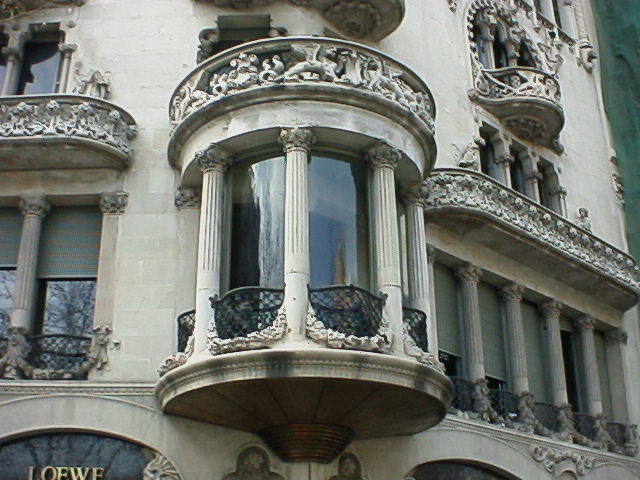
Since we were already at the Casa lleo Morera, we decided to go on the tour of it that was starting in 5 minutes. Like most of the Ruta de Modernisme sights, this one can only be seen by guides tour and it is only available to pass holders. This was originally built as a house for the Morera family in 1902 and was designed not by Gaudi, but by an architect named Montaner in his famous “floral style”.
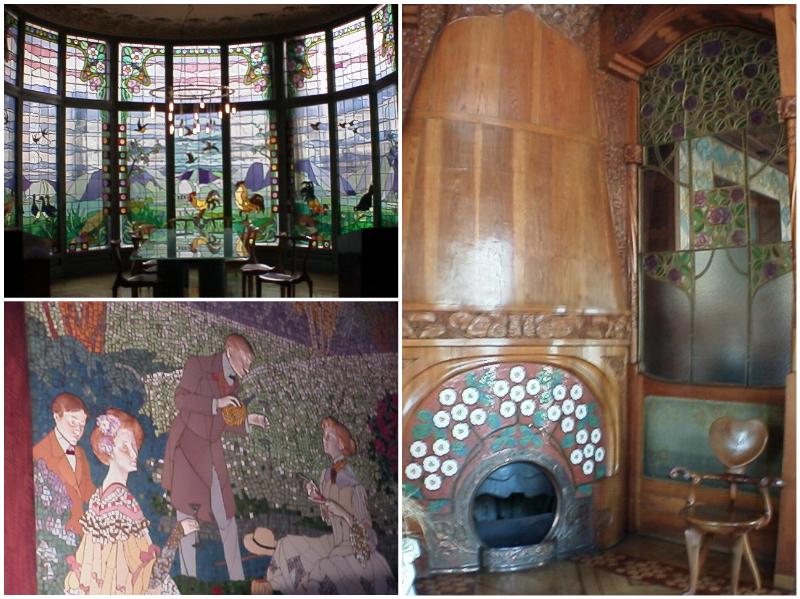
The house is a perfect example of how the expression of wealth to the outside world was as important than as it still is today to many people. The family spent a great deal of money on areas of the house that were visible to the public. For example, there is a sitting area at the front of the building that juts out onto the street like an enclosed balcony. From here, the family to see and be seen to the street below, along with a column of very expensive imported pink Italian marble. However, where the column dips below view from the street, it is replaced with a less expensive piece of white marble. The house contains beautiful wood-carved ceilings and floors, amazing stained glass windows, mosaics, and carved sculptures, each piece made expressly for that house and with symbolic representations for the family.
As you move through the house, from the front to the back formal dining room, the ceilings change from expensive carved wood to plaster, molded and faux painted to look like wood. The dining room is beautiful and has a floor to ceiling, curved stained glass window that was not only extravagant but allowed light to enter the house without making the occupants visible from their neighbor’s back yards. In this same room, there are also gorgeous mosaics depicting a picnic scene, with figures containing porcelain faces, reminding me much of the famous George Seurat painting (see photo page).
From the Casa Lleo Morera, we walked outside on our tour and down the block to look at the Casa Amatller and the Casa Batllo, both distinctly different. These we could only view from the outside, as they were closed to the public and in use as apartments or offices. The outside of the structures however, were as different as night and day. Casa Amatller was built in 1898 for an international chocolate manufacturer and shows a Northern European Dutch influence with a geometrical, stair stepped, top of the house.
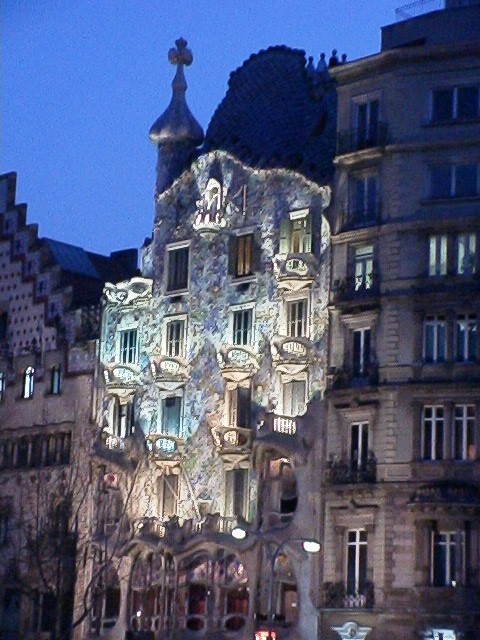
The Casa Batllo is the only house on the block built by Gaudi and is as fanciful as the Casa Amatller is severe. Ever the patriot, Gaudi designed the house as an homage to Saint George the slayer of dragons and the patron saint of Catalan. The roof of the house, when viewed from certain angles is said to appear like the dragons back, there are columns that look like leg bones, and the balconies appear to be the dragon’s eyes. The lines of the building are so fluid that it practically breathes, undulating like a living organism.
That day we also toured the Palau de la Musica Catalana which is a concert hall. Outside, it is covered in brick and tile mosaics and has a balcony where each column is distinctly different. Inside the theater is a beautiful, multi-colored, stained glass, domed skylight that dominates the ceiling. In the evening, we made it just in time for the last tour of the day at Palau Guell, designed by Gaudi in 1896. We toured the huge house, from top to bottom, ending up on the roof with its twenty, unique, mosaic-covered chimneys.
On another note, aside from all the sightseeing, something else momentous occurred that evening for me; I bought a new pair of shoes! For those of you who know me and my affection for shoes, spending the last seven months with only two pairs of shoes (boots and sandals) was not only boring, but downright torture. A couple of months ago, when we arrived in London in winter, I decided that it was time for new shoes, given the inclement weather and the fact that my sandals had broken on our last day in Thailand anyway, I was down to essentially one pair of boots. I spent the next six weeks looking for the perfect pair of shoes that I could wear with both pants and a skirt. And they had to be black. No easy task, even in Europe, for the stores were already filled with spring shoes and giant, gaudy platforms. Anyway, I finally found a great pair of black wedge slip ons that were perfect. I was happy.
David’s Diary:
March 16, 1999
Barcelona
As you may have ascertained, Antonio Gaudi was unique. Not only did his style capture the spirit of the community around him, it practically defines the Catalan self-perception. It is rebellious, and sensuous, and artistic, and one of a kind. It can be interpreted as Catalan nationalism, although Gaudi never ‘explained’ the symbolism of his work, if there was indeed any at all. His buildings lend a fairy tale quality to the capital city of Catalunia that the population are more than happy to embrace and exploit. His master oeuvre is the Cathedral “Sagrada Familia” which stands apart from the rest of modernist Barcelona. The giant conic spires that top the two facades are the only part of the great edifice which stand completed. The work is never-ending on the body of the Cathedral, which the local government pledged to finish according to Gaudi’s original plan. One facade offers an elevator ride to the top of of one side of its towers, from which one can get terrific views, and ride the elevator back down. Or, in the old facade, one can brave the sardine tube ascent of the far right tower, which are the only stairs open from the bottom on this side.
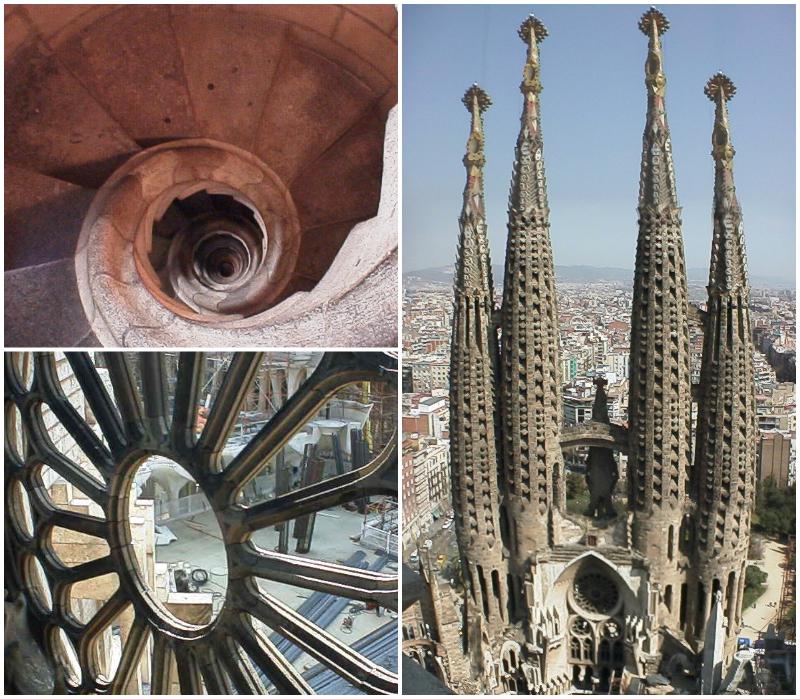
If you can handle the dizzy vertigo-inducing climb squished by those on their way down the steep spiral stairs with no guard rail, you can make it to the first level. From there, bridges and passages connect the four towers and all of their various spiral staircases to a myriad of beautiful vistas and architecturally interesting vantage points. I forced Kristina to wait it out while I made the ascent for the photo of the rose window frame from the outdoor elevated passage that runs just above it. Sometimes the traffic in the lower part of that tube is ridiculous and very dangerous. There is no flow control, and the inclination to panic is rather strong. If it is not too crowded, however, it is more than worth it.
Thanks to my obstinate nature and my need to climb both sides of the Cathedral, we were able to go back and forth along the walkway that spans the future interior of the Cathedral. We made the best of the repeated treks by taking a closer look at the modern technology of cathedral construction. For any of you readers who might not be familiar with David Macaulay’s books: Cathedral, Castle, Pyramids, and a few others, I highly recommend them for folks of all ages, but mostly for kids around 8-12. They deconstruct the historic methods of construction within a creatively spun, semi historic yarn of yore. The scene in between the facades was not unlike the drawings I remember from Macaulay’s books, with small groups of workers concentrating on building the parts, and others assembling them simultaneously.
The major difference was the tools. Instead of stone masons carving columns, there were forms for pouring concrete columns, and carefully wound re-bar skeletons waiting to partake of the wet cement. The concrete columns were then raised, and finally faced with marble. The effect at the end is the same, only the materials and method are slightly different. There were huge band saws specially designed for the task of precision cutting enormous sheets of marble, and different mixers for mortar and concrete. All around was evidence of each stage of construction in the body of the cathedral. It was simple to see the step by step progression. I hope that it is complete in my lifetime, and that I get to see it with the roof on.
We had stopped at La Pedrera on the way to Sagrada Familia and found out that the only English tour was at 6:00 PM just before sunset. This building is considered the darling of the city’s moderniste architecture and is also the seat of the Caixa Catalunya Foundation, which has spent ten years and millions of dollars on restoration. The tour includes the lobby, the attic level, and the rooftop patio.
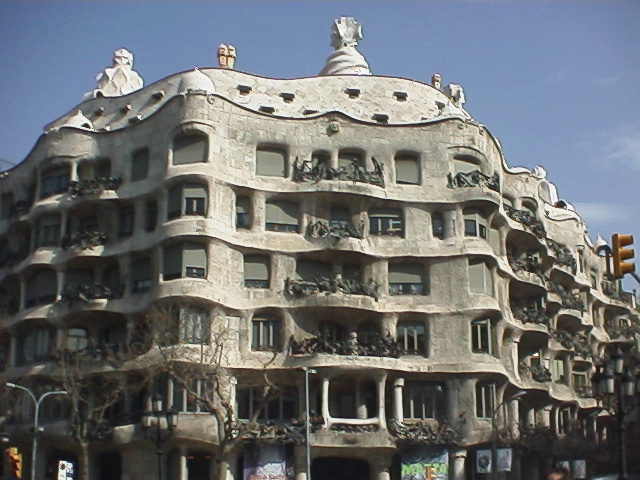
The entire building looks like something out of a Dr. Seuss book. It exists as more than just a tourist attraction. There are at least four different families who actively inhabit the building, and the Foundation has offices on other floors. The attic area of the building is a beautiful space, and there are detailed scale models of all the Gaudi buildings.
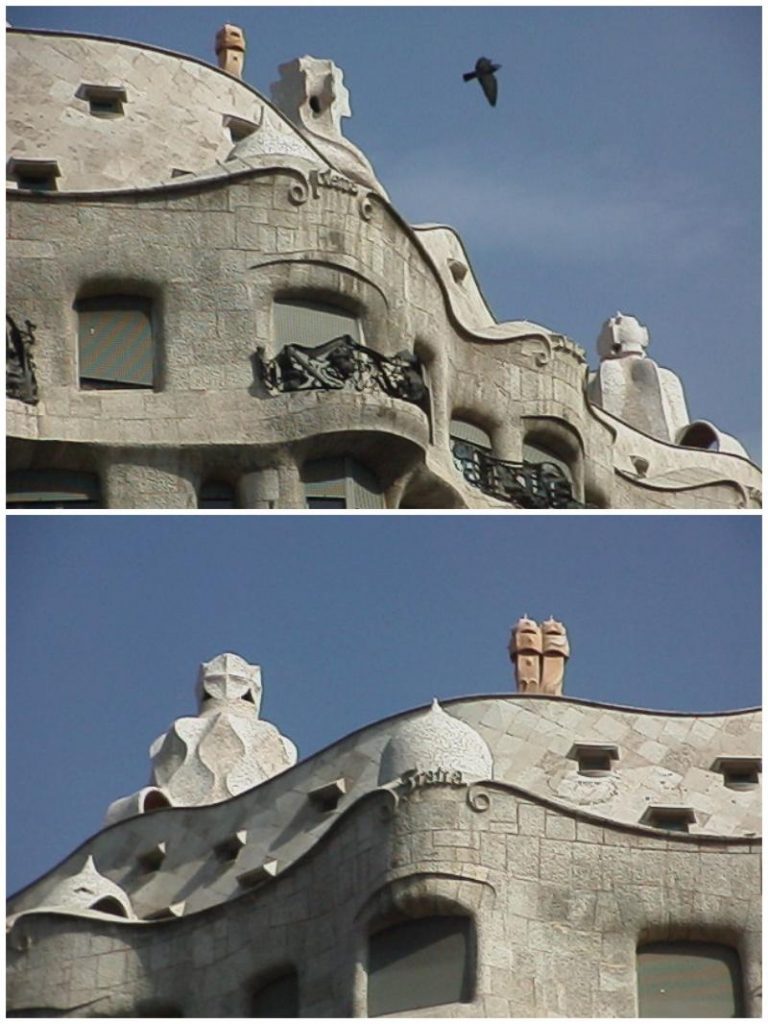
The tour dragged on for an hour, and as the sun was giving way to the colors, Kristina and I gave up on the tour group and made for the roof. Wham! It is the Cat in the Hat land! Undulating walkways flow like waves around the rooftop, with soft-serve twisty cone chimneys in all colors, done in mosaic tile. No two chimneys are alike. The view was spectacular, and the building worth the visit, especially if you don’t have time to visit all the buildings individually, and can only get to one site other than the cathedral.
Barcelona to South of France
March 17, 1999
It was time to leave Barcelona, but on the way out, we had to make a stop at the Park Guell. Gaudi designed a planned community for the avant-garde, but it never took off. The site was converted into a public park. Gaudi’s last house was located in this park and has been converted into a small museum/ shrine to his life and style. The place is worth a visit to see the furniture that he designed for himself. It is beautiful stuff.
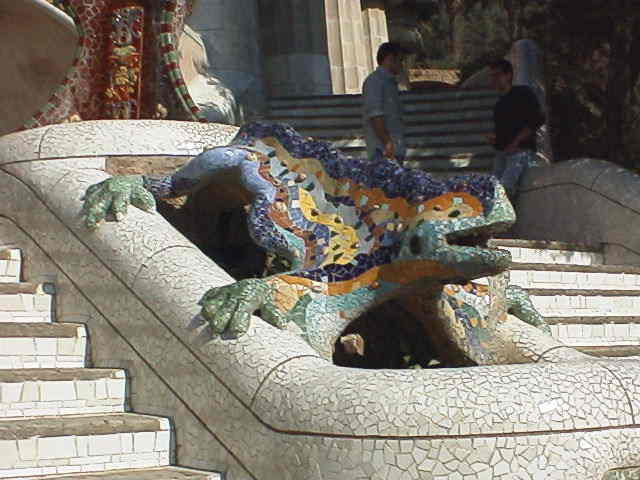
The park has an amazing terrace and with mosaic designs on the iguana fountain, and the serpentine mosaic benches. The two houses at the lower entrance to the park are right out of the fairy tale book.
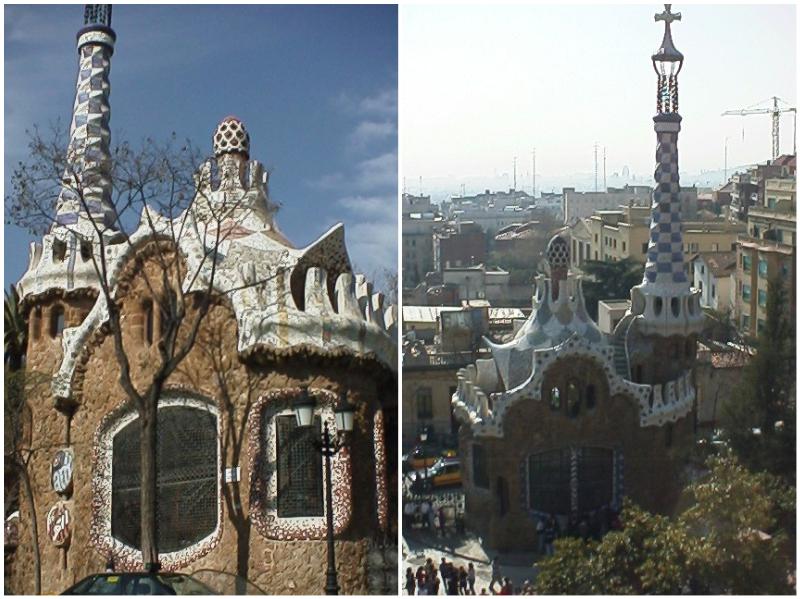
The park has another redeeming factor. It is full of cats. There must be at least fifty of them roaming around. And they get fed by the gardener! We were trying to pet some when they all got up and left us. We saw finally that a gardener on the terrace above had put out several big bowls of food and he was surrounded by cats. Good for the cats, but so much for trying to get our ‘kitty fix’. Kristina tried to find the gardener, and give him our last pesetas for his cat food fund, but he was gone. We had a long drive ahead of us and needed to get going. We planned to attempt to get reservations at a restaurant Kristina found in a Herald-Tribune review, but we had to get to France first, in order to use our French phone card, and call cheaply. The parting was hard, we both had a fun time in Barcelona, but we had just finished the entire Iberian peninsula, and a celebration waited for us at our next stop. We rolled on.
Helpful Guidebooks for Spain:
Eyewitness Northern Spain
Fodor’s Essential Spain
Insight Guides Essential Spain
Have you been to Spain? Thinking of going?
Leave me a comment below and make my day!
You can also find our other travels within Spain here.
Any post on this site may contain affiliate links. Thank you for supporting wired2theworld by using our links to shop, book hotels, or organize tours. If you use them, they cost you nothing extra but we may make a small commission that helps us to continue to provide helpful and free content.

